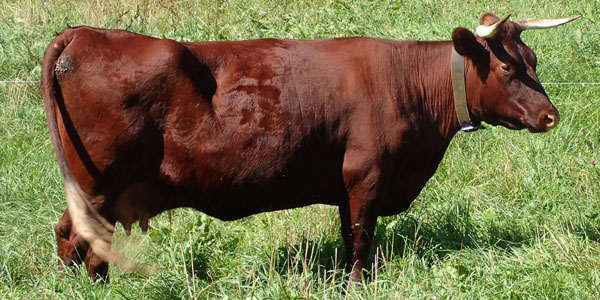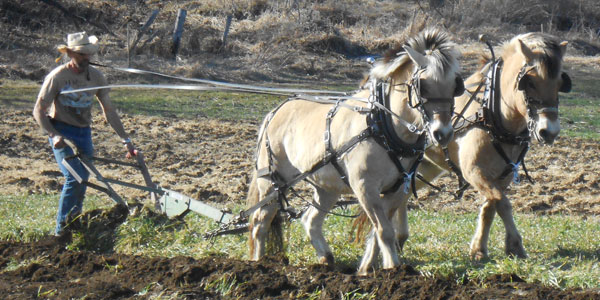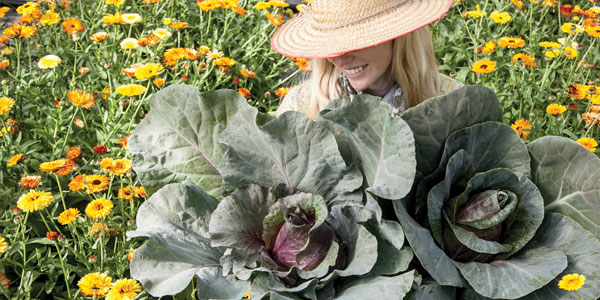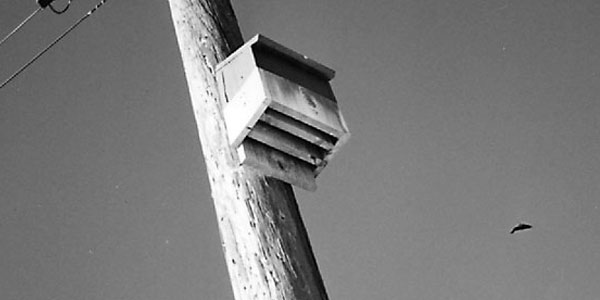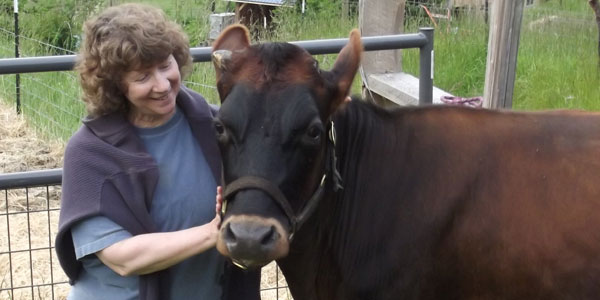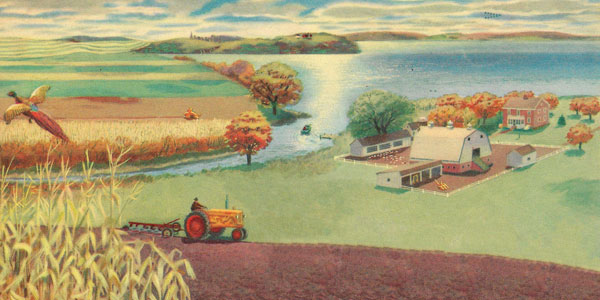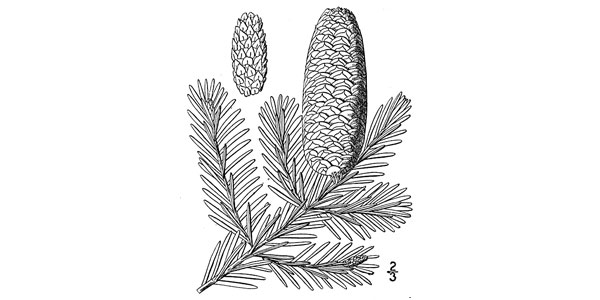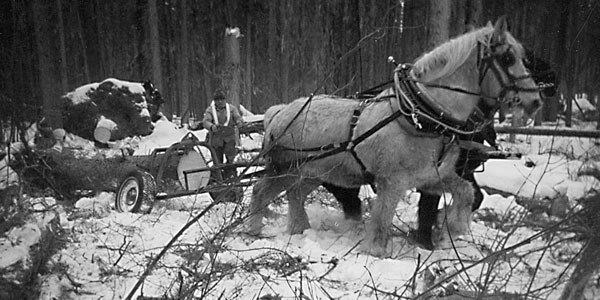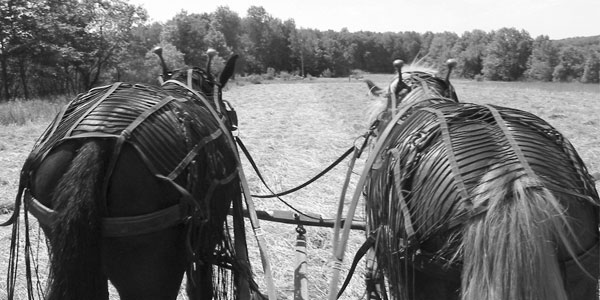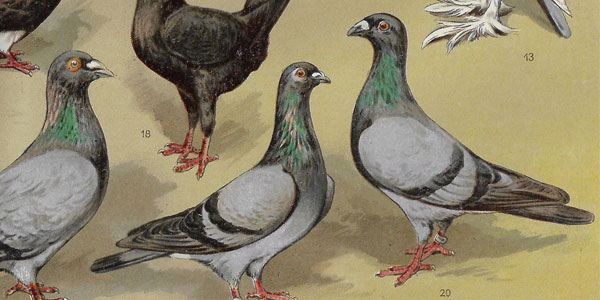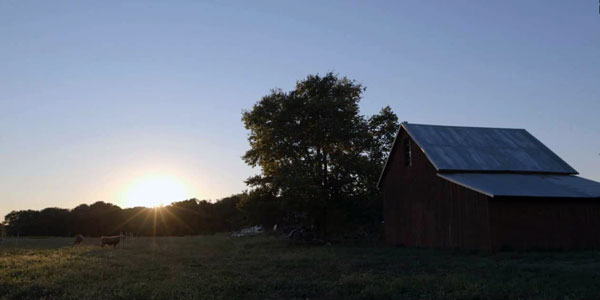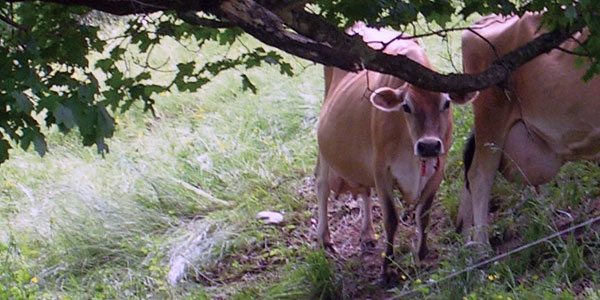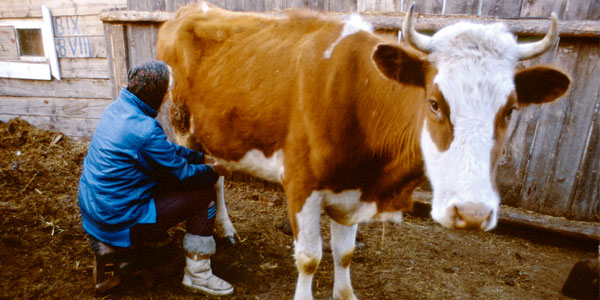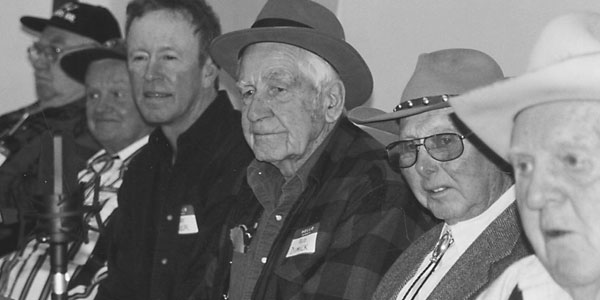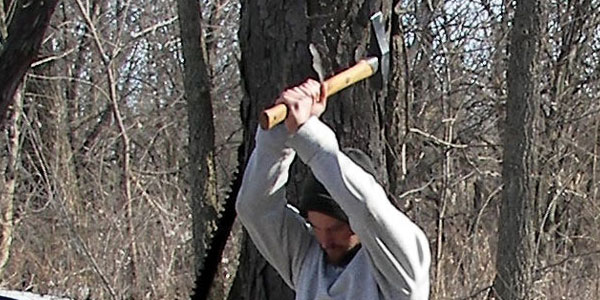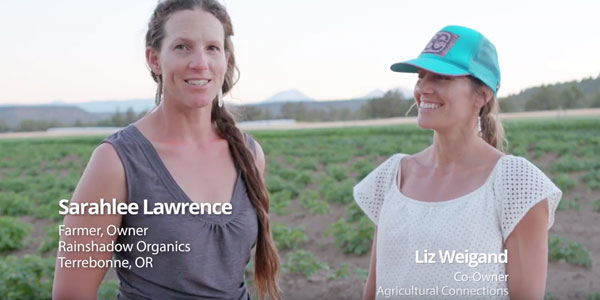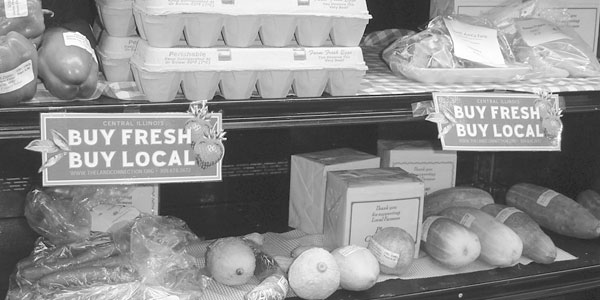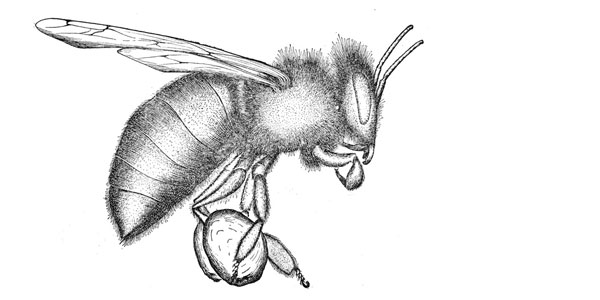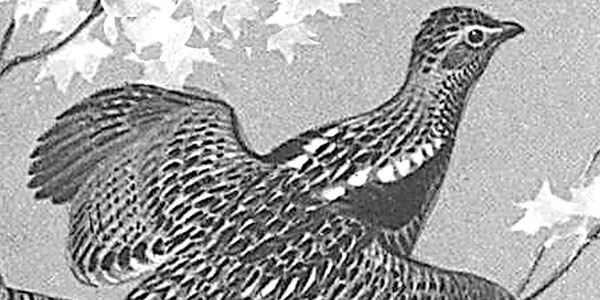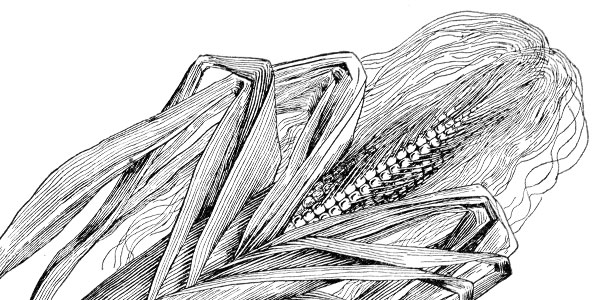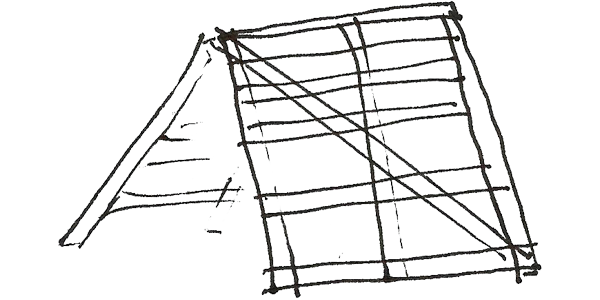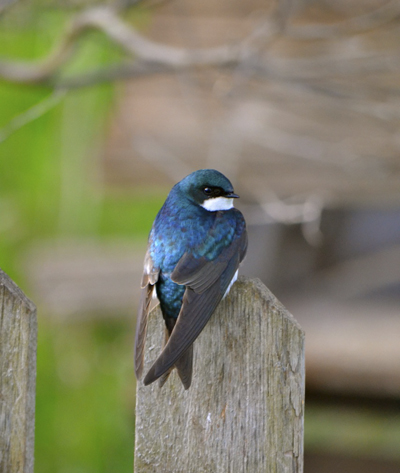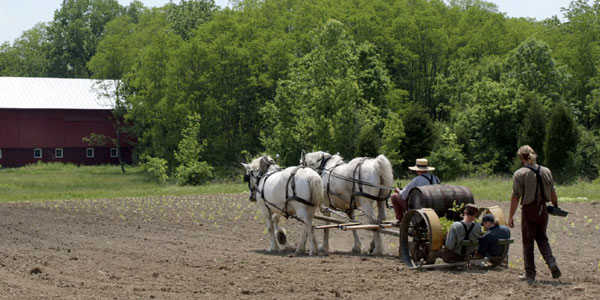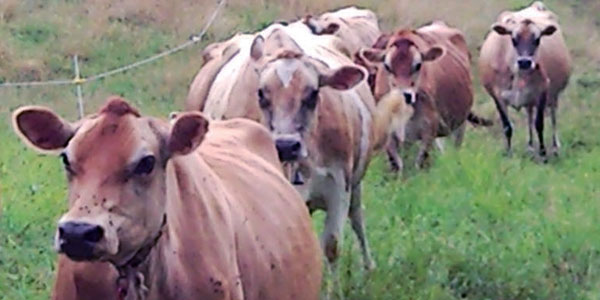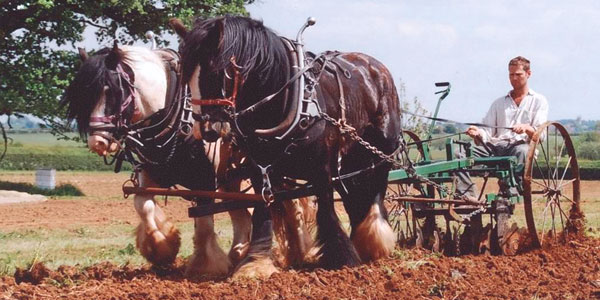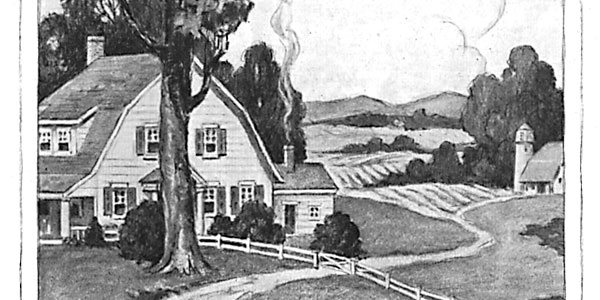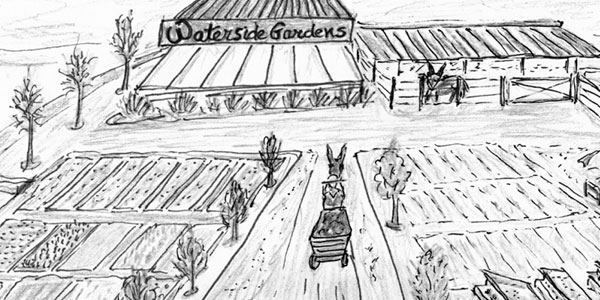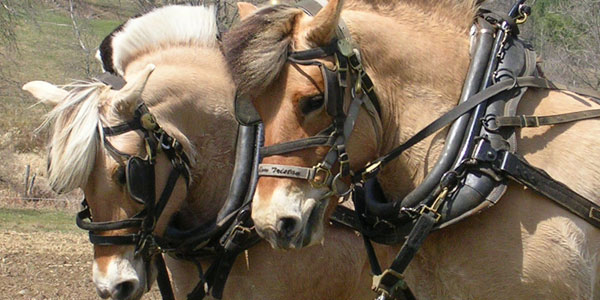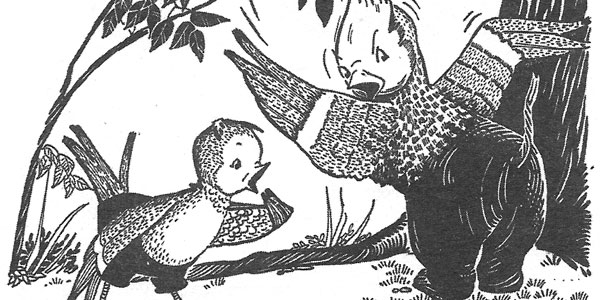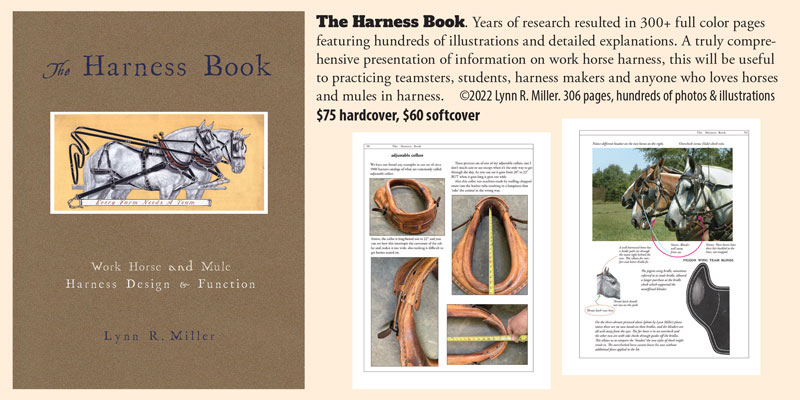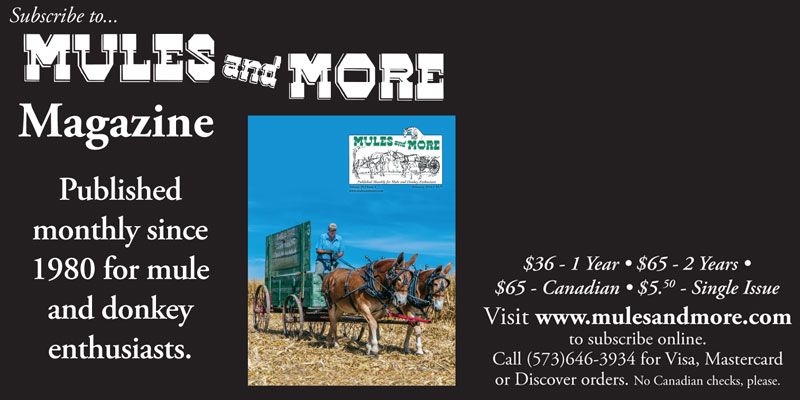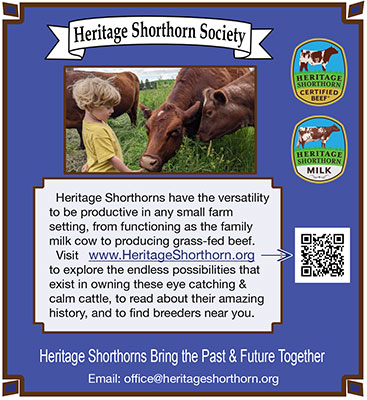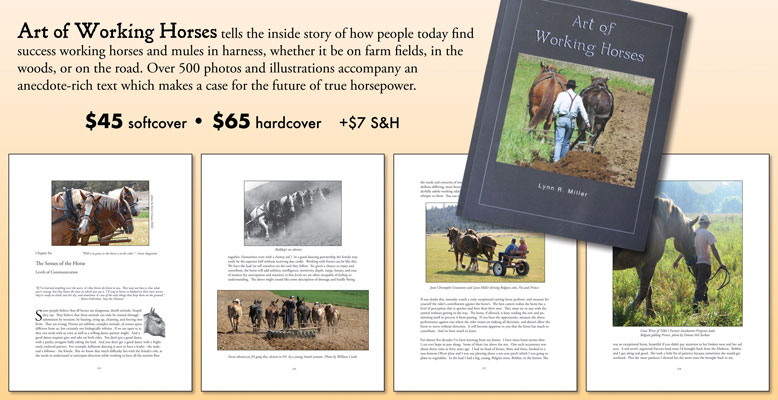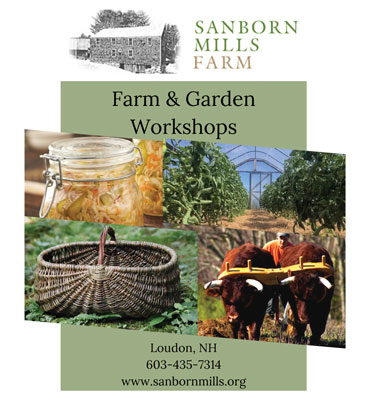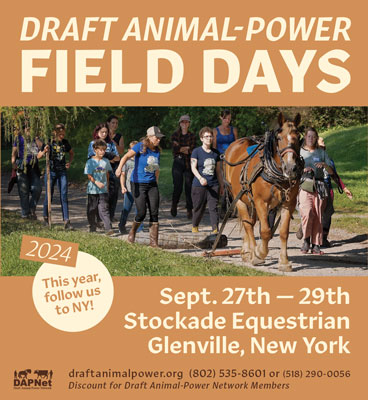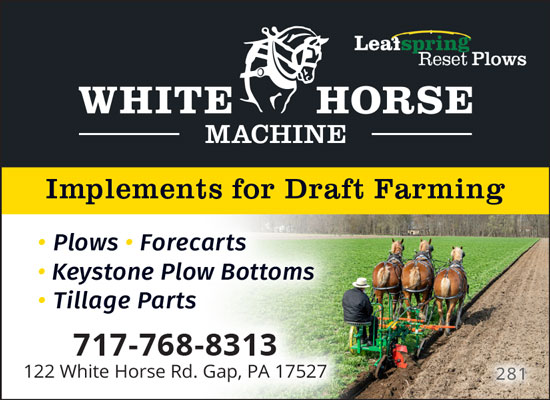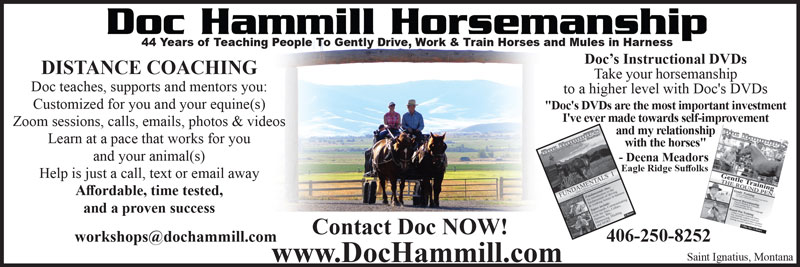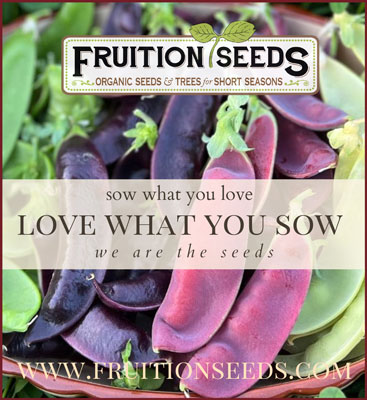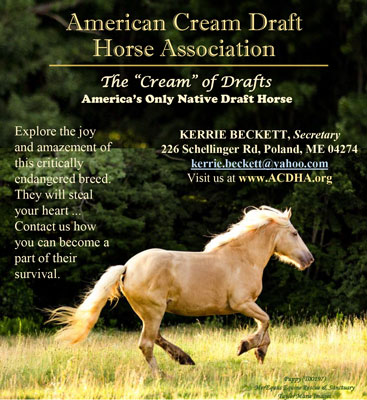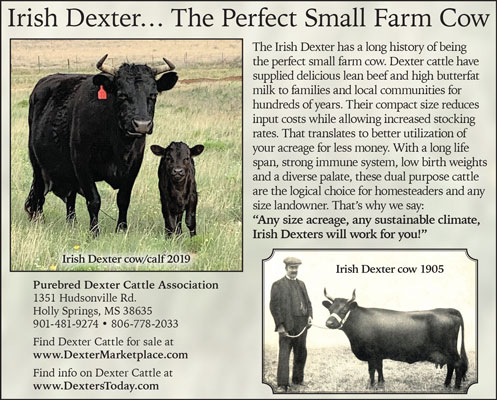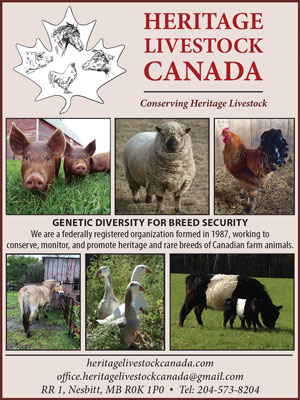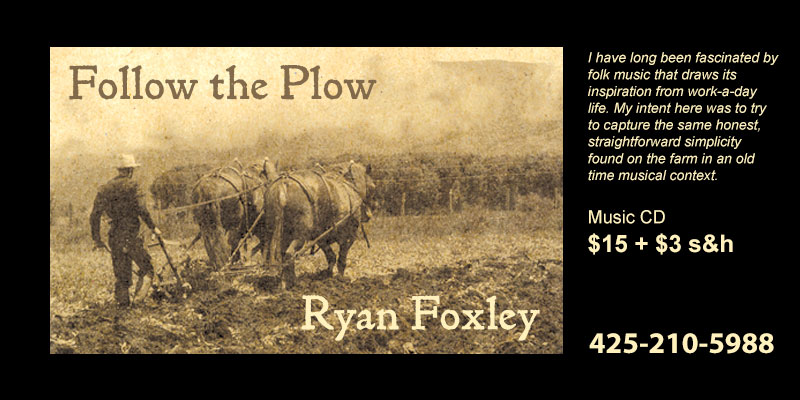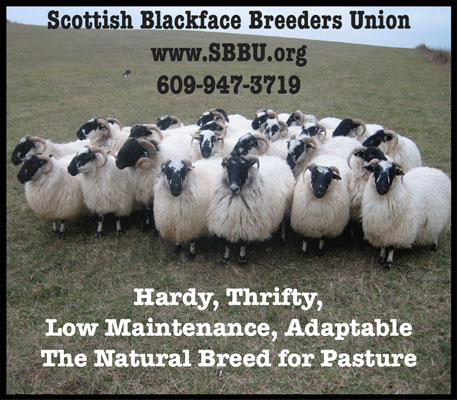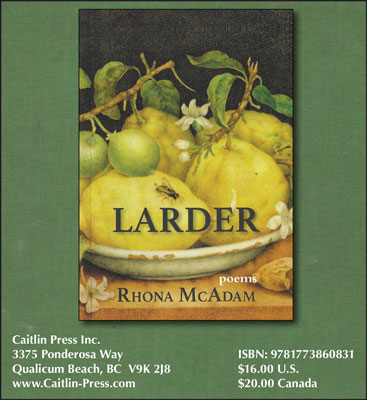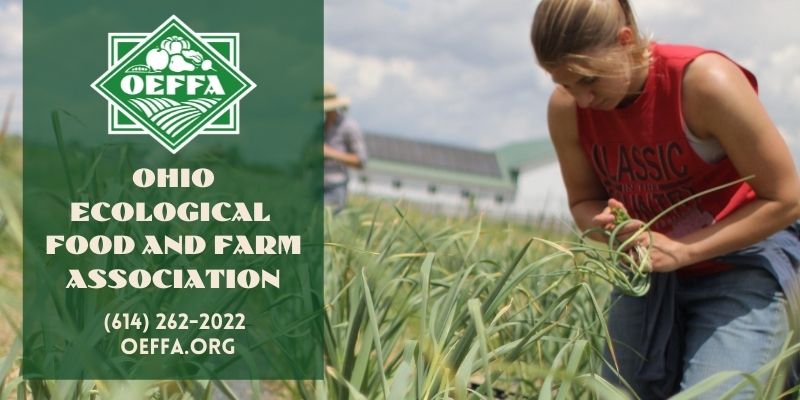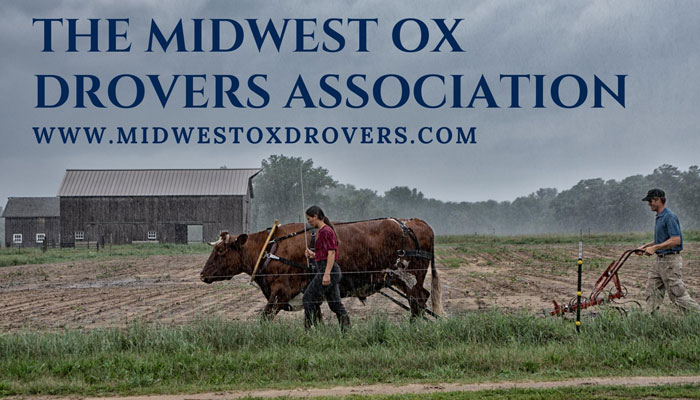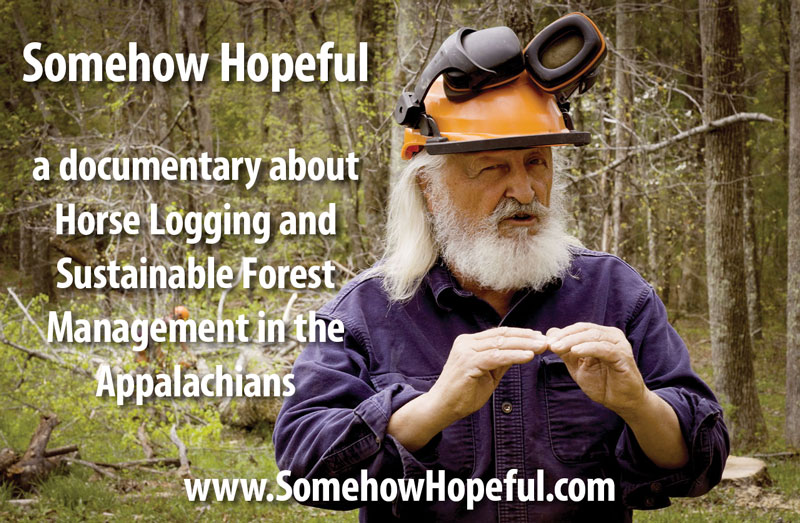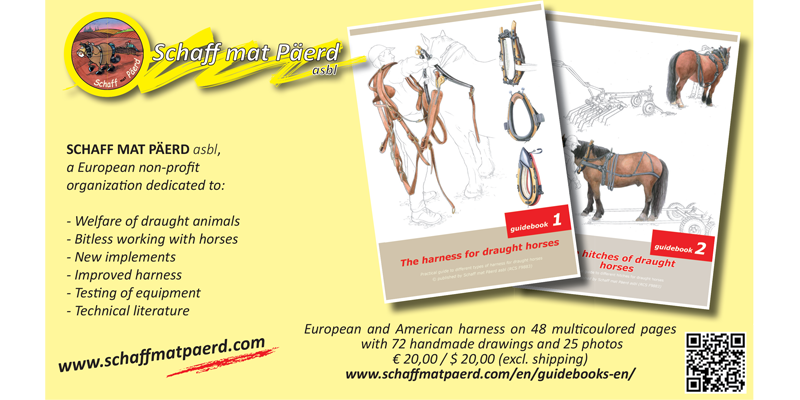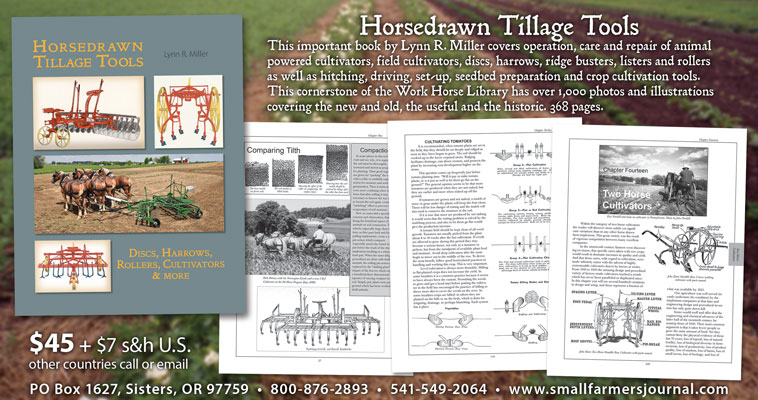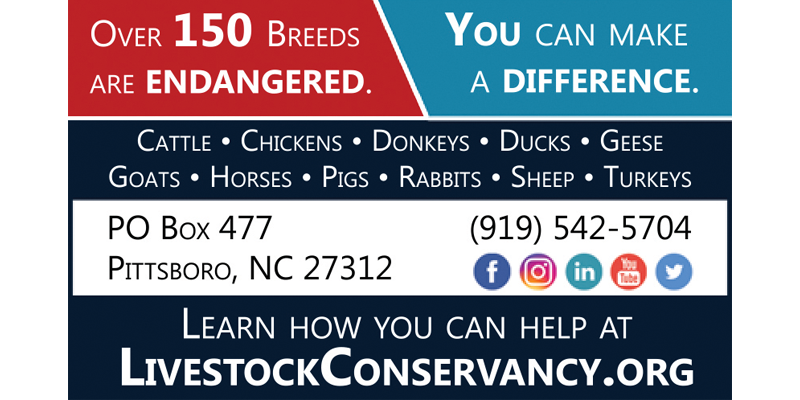MONDAY
April 15, 2024
Ground Driven PTOs
One of the ways tractors both gained and maintained their appeal is from the wider range of machinery they can power with the PTOs they carry. This definitely gave them the advantage over draft power. But is it going to stay that way? It may not have to be on a small farm. During the horsepower road trip Khoke and I went on a couple years ago, we got to see some examples from folks who knew which side of the fence they were on. We saw a number of machines that were reworked and reinvented to make them run off the power source of their choice, namely horsepower.
TUESDAY
April 16, 2024
Headlight Grape
One of the things long desired by Southern fruit growers is a good table grape, sufficiently resistant to leaf and fruit diseases to endure the climatic conditions of their section. Many varieties have been brought forward from time to time; but of the older sorts especially adapted to table use not one, either foreign or native, has yet proved successful over any large area. One of the most promising recent introductions in this field is the Headlight, which was originated by Prof. T.V. Munson, of Denison, TX, in 1895.
WEDNESDAY
April 17, 2024
John Deere Model HH Spreader
Check the adjustments on your spreader and make sure they are in proper operating condition. Hitch your team to the empty spreader to limber it up and see that it is working properly before loading. If you will turn the beaters over by hand before starting to the field, the spreader will start easier and will prevent throwing out a large bunch of manure when starting.
THURSDAY
April 18, 2024
Lost Apples
The mindboggling agricultural plant and animal diversity, at the beginning of the twentieth century, should have been a treasure trove which mankind worked tirelessy to maintain. Such has not been the case. Alas, much has been lost, perhaps forever. Here are images and information on a handful of apple varieties from a valuable hundred year old text in our library.
FRIDAY
April 19, 2024
American Milking Devons and the Flack Family Farm
On a sunny early September day I met Doug Flack at his biodynamic and organic farm, just South of Enosburg Falls. Doug is an American Milking Devon breeder with some of the best uddered and well behaved animals I have seen in the breed. The animals are beautifully integrated into his small and diversified farm. His system of management seems to bring out the best in the animals and his enthusiasm for Devon cattle is contagious.
Are you getting the SFJ Home & Shop Companion?
The Home & Shop Companion is a free weekly email newsletter. It features stories, handy hints, recipes, news, offers, projects, distractions and other stuff we think you’ll find interesting. The entire series is archived here on the website and is free to all to browse: Home & Shop Companion Archive.
SIGN ME UP FOR THE HOME & SHOP COMPANION!
Explore Small Farmer's Journal: Farming Systems & Approaches
Fjordworks: Plowing the Market Garden Part 3
from issue: 38-3
In this series of articles we are taking a look at how contemporary horse-powered farmers are making use of the moldboard plow, with an emphasis on the use of the moldboard as primary tillage in the market garden. In this installment we will hear “Reports from the Field” from two small farmers who favor the walking plow and a report from one farmer who farms tens of acres of forage crops and is decidedly in favor of the sulky. But first, we’ll dig into the SFJ archives to get a little perspective on the evolution of the manufacture of the walking plow from the late 19th century to the present.
Cabbage Re-Imagined:
Plant breeding is, as Irwin Goldman observes, the slowest of the performing arts and this is particularly true for biennials like cabbage, who have evolved to set seed in their second growing season. In the autumn of 2016, as we embarked on crossing a purple cone-headed cabbage with a green one, we dug the roots and be-headed the stalks of about 100 cabbages. After overwintering in our root cellar, we re-planted each stalk in spring and if you’ve never seen cabbage go to seed, it’s quite astonishing. Each darling cabbage down at your feet sprouts a dozen or so spires rising five feet or higher, bursting into hundreds of blooms, canary yellow and cabbage-y sweet. Pollinators flock to the ruckus with long, green pods emerging from each pollinated flower. The sea of green pods turn to gold as the seed matures and we harvest them just as the first pods begin to shatter.
Visioning County Food Production Part 2
Some of the most durable and productive low external input farming systems in history are designed around animals that can accelerate the growth and conversion of plants to fertilizer. Because they are highly multifunctional, ruminant mammals rank highest among these. Beyond their manure production function, they can consume fibrous perennials unusable for human food. These perennials can grow on hill land too rocky or too erodable for many types of food cropping. Used as work animals, ruminants multiply the energy input from human labor many times.
Becoming a Bat Host
Why bother building a bat house? North American bats have, like bluebirds, suffered serious loss of habitat and are in desperate need of good homes. Bats comprise almost one-quarter of all mammal species, and they form an integral part of a healthy sustainable ecosystem. Bats disperse seeds, pollinate flowers, and are major predators of night flying insects. Rootworms, cutworms, stink bugs, and corn ear worms are among the many favorite meals of the common bat. A single bat can consume up to 500 mosquitoes in one hour! A simple and inexpensive step towards improving bat habitat is to provide bat roosting houses (approximately $15 per house) around your property.
A Tale of Two Farmers: Finding Farmland in Coquille
With the average age of an American farmer being 57, much of the nation’s farmland will change hands in the next two decades. To help address this issue, many states and regions are creating land links: programs that help connect farmers, especially beginning farmers, to farmland for rent or sale. Land links are usually online databases that display listings from landholders and landseekers describing what the participant is looking for in a match and what they can offer. The land link program puts this posting online (minus any personal or contact information) and facilitates communication between participants.
Nine Acres of Intimacy
Fortuitously, by January another local farmer stopped by out of the blue one day when I was cleaning out junk that had been piled next to “the hangar” (I will always call it that). He had heard through the neighborhood that I might be looking for a new operator. It was a beautiful afternoon and we had a nice visit, leaning on opposite sides of the pickup bed, discussing the merits of organic methods and other stuff. Though his family operation does very little of it, for a conventional farmer in these parts to even consider non-chemical agriculture was pleasantly surprising.
Critters in the North Country Woodlot
Your thoughts on the use of a forest may differ from what the wild animals in it are thinking, and it is good to be aware of the problems. Animal browse is of two kinds. Critters may eat the buds, foliage, twigs, and leaders, which are accessible only on young trees. Or, they may gnaw the bark of both old and young trees. Foliage and leader browse may change the composition of a young forest, but the trees eventually outgrow the problem. Bark browse is a problem for many years more, though some trees are not affected because their bark is not appetizing.
Teamster Roundtable 2002 Part 1
There are exceptional books written by the British agriculture historian George Ewart Evans among which are “Horse In The Furrow” and “Horsepower and Magic”. In these he recounts stories from the British Isles of the extent to which the teamster’s craft was magic and mystery to be protected. He talked about the fact that when somebody in the British Isles had the obvious and complete mastery of the craft of working those big horses, the tricks of his trades, the little secrets, he had to keep to himself, because when he gave up those tricks and those secrets, he gave up his power. He gave his position in the community. If everybody could do this then he would no longer be special. This became a community dynamic so that there were literally secret societies of teamsters, and they were forever playing tricks on each other and on outsiders, but especially on the novice.
The Woods Betrayed
What of the squirrels, grouse, frogs, mice and fur bearing animals that call this home? They were betrayed by the ones who studied them, lived off them to either be trampled by the machines or try to find a new home as winter set in. Their food supply and homes are gone forever so may many of them be gone forever. What greed does to us!
Hula Hoops & the Driving Horse
I, like many before me, had just entered that gray foggy area where those more timid, or could it be more experienced, fear to tread. I had a thoroughly terrified horse who had no interest in harness or cart, and many knowledgeable horse people told me I had ruined her forever. To find my way out I would have to reach deep inside both myself and my mare, and in the process discover that no matter what people said, it could be done.
A Short History of the Horse-Drawn Mower
Book Excerpt: The enclosed gear, late model John Deere, Case, Oliver, David Bradley, and McCormick Deering International mowers I (we) are so fond of had a zenith of popular manufacture and use that lasted just short of 25 years. Millions of farmers with millions of mowers, built to have a serviceable life of 100 plus years, all pushed into the fence rows. I say, it was far too short of a period.
Pigeon Raising and Squab Production
The pigeon industry has two branches; the breeding of squabs for market, and the raising of breeding stock for sale. The first brings the surest and quickest returns, squabs being safely turned into cash at 4 weeks of age. The second requires more room for raising the young, also more care, more feed, more cleaning of the houses, more advertising, and often involves more losses; but it offers freedom from the unpleasant weekly task of killing and dressing, and better prices for stock sold, if of good quality.
Reconstruction by Way of the Soil Part 5
This advantage of perennial irrigation is brought about by a permanent high level of the river above a dam or barrage placed in its course. Main canals lead off the heightened water from above the dam and minor canals distribute it. It makes constant use of the artificial high level of the river, and, using the water that flows in the river all the year round, it is obviously not wasteful but conservative. But there is one daring thing about perennial irrigation; it alters the age-long habit of river-made soils in arid countries. What it is made to do is, in fact, to treat these arid soils as if they were soils dependent upon frequent rain, for by means of locks and gates there is a giving of water every ten to twenty days.
Light on the Land, Heavy on their Feet – Horse Logging
With his team of horses in hand, Spencer first started cutting firewood off Forest Service land and selling it to the public. In 1985, after four years of cutting firewood by horse logging, the Forest Service, seeing what he was capable of doing, put up a small timber sale in a campground. Today, the Forest Service and land owners see horse logging as a nice tool in managing the land.
Sustainable
Sustainable is a documentary film that weaves together expert analysis of America’s food system with a powerful narrative of one extraordinary farmer who is determined to create a sustainable future for his community. In a region dominated by commodity crops, Marty Travis has managed to maintain a farming model that is both economically viable and environmentally safe.
Fjordworks: A History of Wrecks Part 2
It is always fascinating and at times a little disconcerting to watch how seamlessly the macro-economics of trying to make a living as a farmer in such an out-of-balance society can morph us into shapes we never would have dreamed of when we were getting started. This year we will be putting in a refrigerated walk-in cooler which will allow us to put up more storage-share vegetables.
Traditional Agriculture in Siberia
The agricultural system of the Old Believers has long been one of hand labor. Their homesteads (hozyastvas) were not intended for tractors or horses, with the possible exception of their larger potato fields. Traditionally the small peasant hozyastva has its roots in hand labor, and this has helped maintain the health of the land. Understanding the natural systems is easier when one’s hands are in the soil every day as opposed to seeing the land from the seat of a tractor.
Teamster’s Roundtable 2001 Part 2
Last year we were going up on the wagon train and we were going up this real steep hill and I’ve got stay chains on my wagon, back to the wagon from the singletree and Lori was sitting there by me. There was a big team of Belgians ahead of us. They had stopped. They had played out. The guy had to take them off and Morris Elverud came back and pulled the wagon up the hill for him. Well, anyway, we were going up this hill right behind him and I told Lori I was just going let loose of these lines and see what happens. And that mare pulled that wagon herself up that hill. I didn’t let her go but for twenty or thirty feet but she’s just that type of a horse. So it all depends on what kind of horse you got.
LittleField Notes: Hay
Farming never fails to dish up one lesson in humility after another. Despite having all the weather knowledge the information-age has to offer, farmers will still lose hay to the rain, apple blossoms to frost, winter wheat to drought… If we are slow to learn humility in Nature’s presence we can be sure that another lesson is never far off.
Raised Bed Gardening
Raised beds may not be right for everyone, and our way is not the only way. I have seen raised beds made from rows of 5’ diameter kiddy pools, and heard of a fellow who collected junk refrigerators from the dump and lined them up on their backs into a rainbow of colored enameled steel raised beds. Even rows of five-gallon pails filled with plants count as raised beds in my estimation. Do it any way you care to, but do it if it’s right for you.
Splitting Firewood
Every bit of length, taper, angle, weight and sharpness contributes to how and for what the axe is used. The temper (hardness) of the metal must be hard enough to hold an edge and soft enough to file and not be brittle. A blunter maul with an abrupt taper blows the wood apart, or bounces off if it cannot penetrate. A sharp bit with a longer taper will cut in and penetrate easier before splitting the wood apart. If it doesn’t fully succeed one must pump the handle to loosen the head and hit it again.
Lessons Learned: Life with Livestock Guardian Dogs
We were first introduced to livestock guardian dogs (LGD’s) by our friends the Dillon’s. Will and Debbie milk goats in the coastal mountains of South Tillamook County, and we were visiting them to pick out our first Nubian doe in the late 1990’s. We were greeted by Pete, a Great Pyrenees pup, and an older female Pyrenees. Our first impression was astonishment both at the size of the dogs and at the fact that they were so calmly living in the midst of goat herd pandemonium! We have over the years been treated to many stories of Pete and his companion LGD’s and their escapades.
Small Farm, USA: Cayuse Vineyards
How did the grape find itself here on the outskirts of Milton? If you ask one man, Christophe Baron, the answer is simple. “It’s the cobblestone. (The ground) reminds me of home”. For Christophe, home refers to France and the stone littered earth from which many famous French wines grow. Hailing from a family of vigneron champenois, Mr. Baron came upon this corner of the state by chance, saw its signature geology, and decided to establish his domaine right here in northeast Oregon.
Our Last Crop: Protecting Our Agricultural Land
From the iconic landscape to delicious local food, from our thriving rural communities to important wildlife habitat–agricultural land, also called “resource land”, is part of our way of life.
Red Sorghum in Cameroun
In this part of the world, sorghum is roughly divided into the rainy season kind and the dry season kind. The rainy season kind is the typical red sorghum seen also in the US and called milo. There are many sub species in each category. The varieties allow farmers to harvest twice a year if they have the correct soil. The dry season sorghum requires a flat piece of mostly clay soil. During the rainy season, these flat fields are ploughed in a checkerboard fashion to make squarish ponds so the rainfall will soak into the soil and not drain away.
How To Keep and Milk a Cow
The family milk cow has followed the small farmer through the ages and lives on yet today. She comes in many colors, sizes and dispositions. As with any animal, she comes with the dignity of her own personality and characteristics. Every cow I have ever had or milked has been unique in her own way. Some I have loved and some, well, not so much.
Contributing More Than Calories: The Fairbury Local Food Project
In 2004, a small group of direct-market farmers began collaborating with the co-owners of the local, independently-owned supermarket in Fairbury – Dave’s Supermarket – to initiate an “indoor farmers’ market” inside the grocery store. The farmers wanted to provide Fairbury residents with food grown locally and without pesticides, while finding viable markets for their farm products in their own community. The supermarket sees the sales of local produce from local farmers as a public relations tool to continue to draw in customers and help support their local farmers. The business arrangement between the store and farmers is simple: the farmers stock the shelves with their local products, and the store advertises and provides codes for the products to scan through the checkout lines.
Mysteries Surrounding CCD
As most of us know, bees swarm — that is, leave the hive en mass — for several reasons. The most common reason is a lack of room to grow, when there are plenty of blooming plants in the vicinity. When bees swarm, they hatch out a new queen and follow her to find a place to build a new hive. By contrast, in Colony Collapse Disorder the bees slip away as individuals, leave their posts and duties, signalling some kind of failure. Perhaps they only leave in a last desperate urge to avoid fouling the nest with their corpses.
Partridge, the Northern Apple Grower’s Nightmare
Apple orchards suffer from a wide range of problems. The worst of all is not moose, deer, rabbits, voles, round-headed apple tree borers, sawfly, codling-moth, curculio, or scab. It is a bird, the ruffed grouse (Bonasa umbellus), known locally by the nickname partridge, which is the term I will use in this article. Partridge eat the buds of trees in the winter, and apple buds are among their favorite foods. They eat both leaf and flower buds, but leaf buds will regenerate the same year. Flower buds will not; they require two years in formation. If you lose all your flower buds, you will have no apples. Just one partridge is easily capable of “budding” an entire small orchard over the course of the winter.
Seed Savers 451
“Today so few people farm that vital knowledge of how to farm is disappearing. The average age of farmers is over fifty-five and approaching sixty. The proportion of principal farm operators younger than thirty-five has dropped from 15.9 percent in 1982 to 5.8 percent in 2002.” After I read Heinberg’s little monograph, the final scene from ‘Fahrenheit 451’ flashed in my mind’s eye. But this time, they were not reciting great works of literature – they were reciting farm manuals about soil, compost, microbes, beneficial insects, cover crops and more. The entire Rodale catalogue of books was personified.
The Road to Better Corn is “Open”
Most farmers take it for granted that hybrid corn will yield more, acre for acre, than an open-pollinated variety. However, as advocates of OP corn have always been apt to point out, yield isn’t everything. OP corn is well known to be more nutritious than hybrid strains, having more minerals, free sugars, and protein and less plain starch. Even animals will almost always preferentially consume OP ear corn if given a choice between it and a hybrid. Moreover, the wider gene pool of OP corn makes it resistant and/or tolerant to a wider variety of microbial diseases and insect pests.
Fjordworks: Cultivating the Market Garden With a Single Horse
A farm is never a static entity, a healthy farming system is something that grows and learns and builds upon itself with experience and time. Any successful farming system is ultimately the summation of an intelligent response of the farmers, eked out through years of trial and error, to the unique characteristics of their particular piece of ground. The farm cannot exist as a fixed point in time but only as the cumulative result of cyclical effort, exhaustion, and rejuvenation.
The Milk & Human Kindness: What I’ve Learned of Tri-Pod Haymaking
I have no doubt that when the time comes we are going to need to know how to make hay this way, whether it be this Proctor Tripod method, or the French rack method illustrated in André Voisin’s great book “Grass Productivity” or the Scandinavian “Swedish Rider” method of tightly strung wire “fences” for hay to dry on. Each method has its pros and cons, and it’s my belief that the “Swedish Riders” is the easiest to learn and the Proctor Method may be the most difficult.
Farm to School Programs Take Root
Vermont has been a Farm to School pioneer, with a long history of engagement and partnership by farmers, school leaders, non-profit organizations, state agencies and local businesses. Farm to School in Vermont often advances a comprehensive agenda, working to integrate local food and farms into the cafeteria, classroom and community – or the “three C’s.” Around Vermont, various regional groups have emerged to work together around these goals and support the more than 200 schools with Farm to School efforts. Following is a series of three articles that describe farm to school efforts from different vantage points. All three authors live in Hartland, Vermont.
Congo Farm Project
I was at day one, standing outside an old burnt-out Belgian plantation house, donated to us by the progressive young chief of the village of Luvungi. My Congolese friend and I had told him that we would need to hire some workers to help clear the land around the compound, and to put a new roof on the building. I thought we should be able to attract at least 20 workers. Then, I looked out to see a crowd of about 800 eager villagers, each one with their own hoe.
Rotation As A Means Of Blight Control
Every farmer knows that when a crop is grown on the same field year after year, it becomes inferior in quality and the yield steadily diminishes.
The New Farm Cook
Used to be that farm cooking meant an eggs-and-bacon breakfast cooked by the wife before dawn, followed up with a meat-and-potatoes lunch and a hefty slice of pie. The archetypal farm wife was an accomplished cook who did simple, stick-to-your-ribs home cooking, fuel for the men who toiled 15-hour days in the fields. Today, everyone cooks and eats differently from a generation ago, including farmers. So we went back to the farm to take a peek in the kitchen.
Carriage Hill Farm Visit
Cornfields in the 1880s were laid out much differently than those seen today. To recreate a cornfield during the time period it is laid out in check rows. The field is prepared and then marked using a marking sled. Afterwards, the farmer moves across the field perpendicular to his markings with an original corn planter. A knotted wire is stretched across the field which when tripped causes a kernel of corn to fall into place in the dirt. Rather than being planted in long straight rows, the field is actually laid out more like a checkerboard. The idea behind this is that the field could then be cultivated in all directions, including diagonally.
Fjordworks: A History of Wrecks Part 1
I am certainly not the most able of dairymen, nor the most skilled among vegetable growers, and by no means am I to be counted amongst the ranks of the master teamsters of draft horses. If there is anything remarkable about my story it is that someone could know so little about farming as I did when I started out and still manage to make a good life of it.
The Old Woodstove
The decision to put in a cook stove was actually not made quite so lightly. We try to minimize our use of fossil fuels if alternative energy sources can be found. For many energy uses, alternatives are readily available, but cooking is a tough issue. However, we all need to cook, and many of our foods don’t have the same nutrition if they aren’t cooked. Many are certainly less palatable. Solar ovens work well under the right temperature and culinary conditions, but early morning is not the right time or place to make granola in one. Solar electricity may be an option, but resistance heating eats up precious solar-produced watts faster than anything.
Cultivating Questions: Alternative Tillage & Inter-Seeding Techniques
Our intention is not to advocate the oddball living mulches we use with this single row inter-seeding system, but just to show how it is possible to utilize the between-row areas to improve insect habitat, reduce erosion, conserve moisture, fix some nitrogen, and grow a good bit of extra organic matter. If nothing else, experimenting with these alternative practices continues to keep farming exciting as we begin our twentieth season of bio-extensive market gardening.
Chagfood Community Market Garden
Chagfood Community Market Garden is a CSA supplying 80 shares a week from five acres, on the edge of a small town called Chagford on the northern edge of Dartmoor National Park, in Devonshire, England. Chagfood has been running since 2010 when it was set up by Ed Hamer and his wife Yssy. Having been born and brought up in the National Park, Ed was aware that many of the traditional farming skills and knowledge of the area have been lost as farming has become more intensive. As a result he was keen to use working horses on the market garden from the very beginning, in an effort to keep the skills of working horsemanship alive for the next generation.
Pollo Real
Tom Delehanty is a sixth generation organic farmer, and has been raising meat chicken for over 15 years. He moved to Socorro from Wisconsin in 1994 to start Pollo Real and lives there now with his wife and their two kids. Although they are only ages four and seven, Delehanty described them as the seventh generation of farmers, as they are beginning to help with the chores. Throughout his career, Delehanty has learned about different types of poultry farms in order to help him develop his own pastured poultry method in which he keeps two ideas in mind: the health of the chicken and keeping a natural environment.
How to Choose a Farm / The Poor Man’s Farm
But to all who really want to farm – to accomplish something in developing a high agriculture along sane and wholesome lines – I would say, “Do not have too large a territory.” Not that I advise a really small one, but simply one within reasonable bounds. For beyond a certain limit it is not the size that counts. Not far from where I am now writing, for instance, is a farm of eight hundred and fifty acres, of which certainly seven hundred are arable land; and at about the same distance in another direction is one of only seventy acres that produces more than the big one.
Visioning County Food Production Part 5
Ideally this process would be part of a general physical redesign of both the urban and hinterland communities according to the model that emerged in Europe, where centuries of higher population densities have dictated more careful land use planning. Even today, European towns large and small are characteristically dense clusters of buildings that end abruptly in agrarian vistas.
Why Work Horses
After finishing one field, it was our custom to loosen the wires between two fields and staple them securely to the bottom of the posts, driving over the wire into the adjoining field. In my haste, I was careless in properly fastening the wires on the bottom of the posts and one of the horses struck the wires causing them to fly up and before I was finished, the pole of the rake, which had cost in the neighborhood of $2.50, had been broken squarely in two. I think I would just as soon have reported to the sheriff that I had robbed a local bank as to be faced with the responsibility of reporting this difficulty to my Uncle. His only remarks were: “Kid, it isn’t what you make that counts, it’s what you save.”
Visiting Gardens
While we visited the allotment, we all pitched in with a hoe or a trowel to remove some of the weeds, but we also took a little tour around the two-acre allotment site, sandwiched between a railway line and a sports field. I have always liked allotments; some people might see them as messy and untidy, with old pallets, wonky and fading sheds, plastic cups and food containers, wooden boxes, old CDs and other junk pressed into service to hold up netting, to shelter plants, collect water or scare the birds. But I like the variety and the fruitfulness, the ingenuity and attention, the money saving and the commitment, and I love the atmosphere of quiet and companionship as every allotment holder shapes their plot in the way they think fit.
Fjordworks: Primary Tillage at Cedar Mountain Farm Part 1
Primary tillage is the first step in readying land for the reception of seeds or transplants. Just as the gardener breaks ground with a spade, and then breaks up clods with a hoe, and finally levels all with a rake, so does the farmer have a basic armory of tools to perform these functions on a larger scale in order to create a seed bed. Our primary tillage begins with the moldboard plow.
Horsepower Units
When I wrote about Khoke’s grandfather rebuilding a 7-sweep rotary horsepower unit, I wrote briefly about some technical issues we ran into. To this, we got a response from John Brubaker, the community mechanic for the Winchester Mennonite community near Hillsboro, Ohio. John suggested we come to see the five 2-horse treadmills connected to power the silage chopper in the fall. He also suggested that it might be worth our time to check out the Scottsville Horse and Buggy Mennonite community in southern Kentucky. This community is only 50 miles west of the Vernon community near Hestand, Kentucky, where our longtime friends, the Bye family, lives. Before our travel plans were finalized, they also included a stop at the Delano Mennonite community in Tennessee as well.




